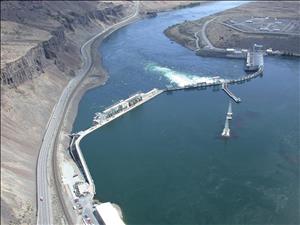On January 27, 1930, construction begins on Rock Island Dam on the Columbia River. The dam straddles the river between Chelan and Douglas counties about 12 miles southeast of Wenatchee. It is 453 miles from the mouth of the river at the Pacific Ocean near Astoria, Oregon. The dam will be largely completed by the end of 1931, and fully completed in 1933. It is the first dam built on the Columbia River, but its construction is not related to the massive projects that will later be undertaken by the U.S. Army Corps of Engineers to dam other stretches of the river.
Creation
By the early twentieth century, Washington's new settlers recognized that the Columbia River had excellent capacity to produce electrical power for the young, growing state. In Wenatchee, the county seat of Chelan County, the first local newspaper article to discuss building a dam to harness this power appeared in the Wenatchee World in 1918. Local chatter continued through the 1920s, but it took time for talk to turn into action.
Stone and Webster, an electrical-engineering consulting firm that specialized in acquiring and developing transportation systems as well as utilities, investigated a site on the river southeast of Wenatchee in the late 1920s and found it suitable for a dam. The firm also managed utility companies, including the Puget Sound Power and Light Company (Puget Power), and it was one of Puget Power's subsidiaries, Washington Electric Company, that obtained approval to build the dam in October 1929. However, Stone and Webster contracted for the project.
Construction
Rock Island Dam gets its name from the community of Rock Island, located about seven miles southeast of Wenatchee. A Native crossing-point of the Columbia River in pre-settlement days, Rock Island became a booming town when construction of the dam began. The work got underway on January 27, 1930. Sources give several price tags for the dam, most relatively close to each other; the most consistent figure is $13.5 million, which translates to approximately $220 million in 2021.
The dam is located just below Rock Island Rapids, about five miles southeast of Rock Island. Here the Columbia River is bisected by a rock outcropping that splits the river into two channels colloquially called the east channel and the west channel. Work proceeded first on constructing the dam across the east channel, which included building the powerhouse, while cofferdams diverted river water into the west channel. Workers were fortunate in 1930. It was a dry year, and there was not the usual rise on the river that spring. This allowed construction to proceed faster than anticipated, and by April it was two months ahead of schedule. By December, it was six.
Work began over the west channel in 1931. Though the weather was less cooperative than it had been in 1930, water was flowing through the dam's gates by December 1931, and the structure itself was largely complete. A transmission line that crossed the Cascade Mountains from the dam to Skykomish in King County had also been completed. Two of the dam's generators were intended to be in operation by this time but, although they had been installed, they were still being tested as 1931 ended. Two more generators were installed during 1932, and work on the powerhouse and the rest of the structure on its western end was completed. (The 870-foot-long powerhouse was built to house 10 generators, but only four were installed in the 1930s because at the time there was no need for more power.) On February 1, 1933, Stone and Webster turned over operation of the dam to Puget Power.
The dam measures 3,800 feet long and has 32 spillway gates. Despite early talk that it would provide irrigation to the area, the dam's sole purpose is to generate electricity. It was originally built with two fish ladders, one located on each end of the dam. Concerns over insufficient fish migration through the ladders led to the construction of a third fish ladder through one of the center spillways in 1936, leaving 31 operating spillway gates.
Expansion
In 1951, the Aluminum Company of America (ALCOA) began building a large aluminum plant in Malaga, an unincorporated community on the western shore of the Columbia River just above Rock Island. The plant required a larger amount of power than the dam could produce, which led to installation of the long-planned six additional generators. This required a significant expansion of the structure in which the dam was raised about 12 feet and the powerhouse was modified to accommodate the new larger and more powerful generators. Work began in July 1951 and was completed in April 1953, at a cost of $33 million (approximately $330 million in 2021). A small backup generator in the powerhouse brings its current number of generators to 11.
Puget Power sold its interest in Rock Island Dam to the Chelan County Public Utility District in 1956, and the district has been sole owner since. In 1975, construction began on a new, 470-foot-long powerhouse adjacent to the shoreline over the west channel of the Columbia River. The $53 million powerhouse (approximately $250 million in 2021) with its eight generators was online by 1979. In 2021, the 19 generators in the two powerhouses have a total generating capacity of 624 megawatts and generate enough power to serve nearly half a million people.

